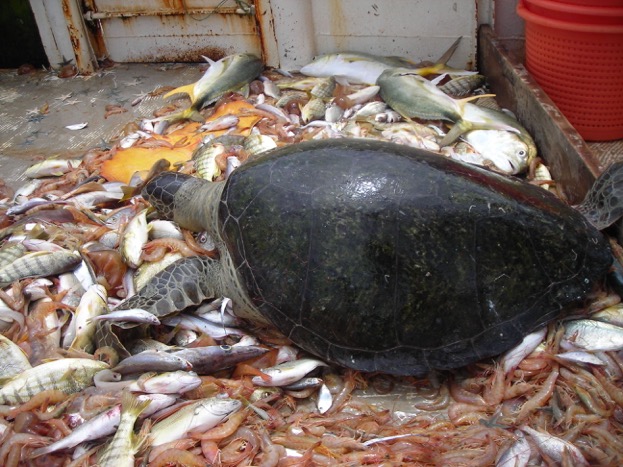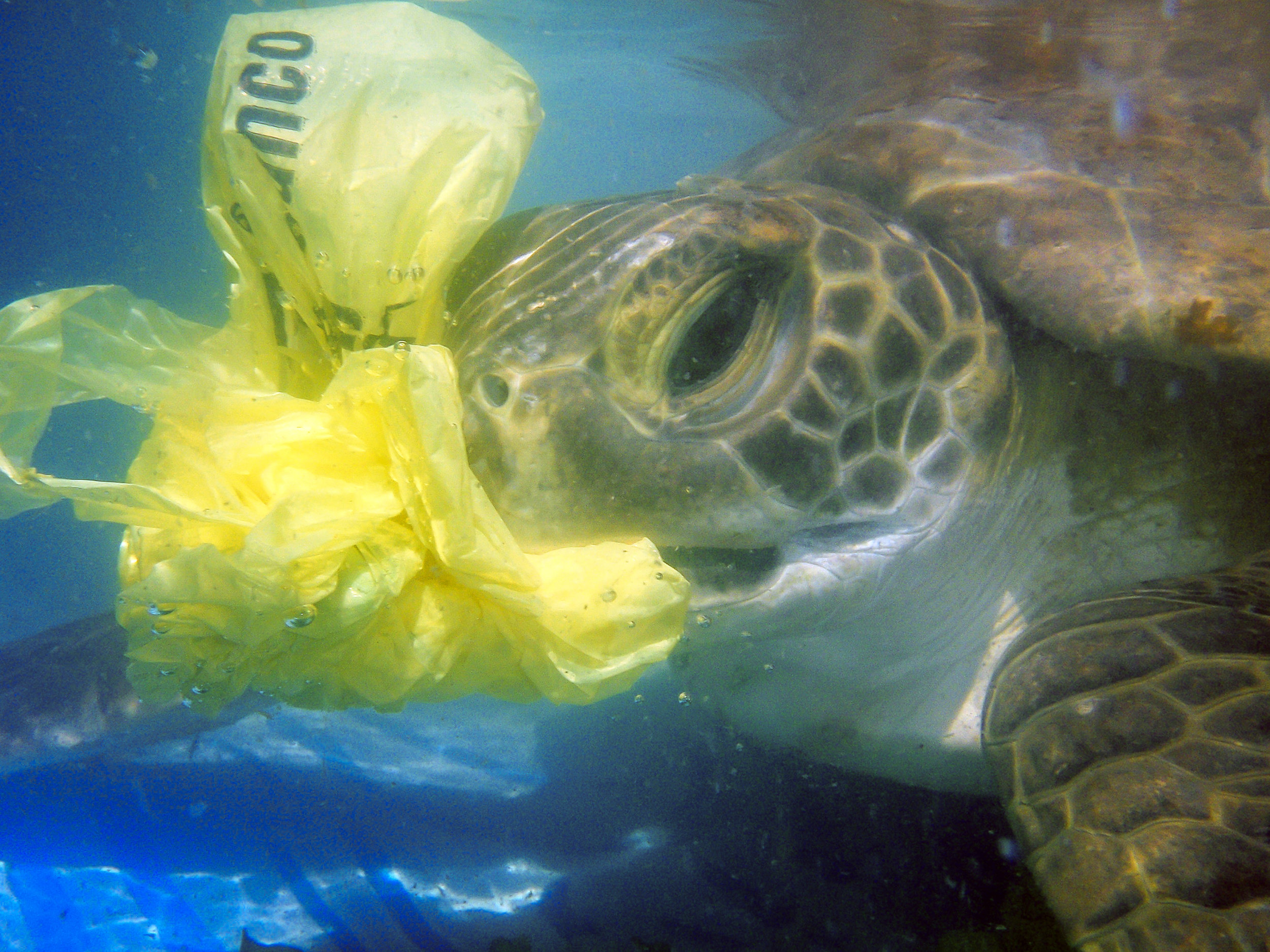How You Can Help Save Sea Turtles
Tips for Ocean-friendly Living
Where do you call home? Is it near a beach? The heart of a city? The peak of a mountain? Wherever it is, sea turtles and the threats they face are closer than you might think.
We live in a world of interconnectedness; the threats that endanger sea turtles and other marine species—fishery impacts, coastal development, poaching, pollution, and global warming—result from human behaviors that we all have the power to change. Many of the choices you make in your daily life affect sea turtles in some way, which means you have the opportunity to help sea turtles eavery day! Following are some of our tips for living a more sea turtle-friendly, and ocean-friendly, lifestyle.
Leatherback entangled in fishing gear. © Kate Charles
A green turtle incidentally captured in a shrimp trawl. © Michel Nalovic CRPMEM Guyane/WWF French Guiana
How can you help sea turtles?
Minimize Fishery Impacts
The seafood that you choose to eat can have a positive or negative impact on sea turtles and other marine life. Smart seafood choices are good for everyone: sea turtles, oceans, fishermen, and the communities they serve.
Choose your seafood wisely
Online resources such as Seafood Watch (also available as a mobile application) and certification programs like the Marine Stewardship Council help you choose the most ocean-friendly seafood options, whether at home or out on the town. Follow sustainable seafood guidelines and use your purchasing power to help improve this key industry.
SPREAD THE WORD
Teach your friends and family about the impact of their seafood choices. Partner with local community groups, schools, and businesses to teach the rest of your community about eating sustainably caught seafood in your area. Talk to restaurant staff, grocery store managers, and other members of your community about the importance of sustainable seafood choices.
Vote for the ocean
Stay informed about fisheries issues and let your government know that you support a better regulated fishing industry that protects the marine environment. Vote for elected officials who are committed to ocean stewardship.
Plastic ingestion is a big and growing problem for sea turtles. © Karumbé
Volunteers collect trash on the beach in Hawaii, U.S.A. © Oceanic Society
Reduce Pollution
Pollution affects sea turtles in many ways, both directly and indirectly. Take stock of the goods that you use and decide what you can substitute for more environmentally friendly products, and what you can do without altogether.
Reduce, Reuse, Recycle
Reduce, Reuse, and Recycle remain the consummate pollution-mitigating rules to live by. The less you consume single-use products and the more effectively you use items you already have, the better. Switch from disposable plastic bags to reusable cloth bags and from disposable plastic bottles to reusable metal or plastic bottles.
Consider a product’s entire life
Support companies that are committed to the best environmental practices throughout their production chain and who plan for what happens to their products when you’re finished with them. Where does the company get its raw materials? What do they do with production waste? Can individual components of the products be recycled after use?
Participate in or Organize a cleanup
Even if you don’t live near the ocean, your waste can be carried there in rivers or on the wind, causing damage to sea turtles and other marine life. Don’t let it get that far! Join the annual International Coastal Cleanup or bring your community together independently to collect trash along the shores of a local waterway, park, or street.
© Wildlife Friendly Enterprise Network
Furniture covers a sea turtle nesting beach in Calis, Fethiye, Turkey. © Medasset
Protect Coastlines
Coastlines are special places that we share with many species, including sea turtles. By making better choices about how we use these areas, we can help ensure that they remain vibrant and healthy for generations to come.
Support turtle friendly tourism
When planning your next beach vacation, choose to stay at a hotel or resort that is working to protect its surrounding environment. If traveling to a sea turtle nesting area, confirm that the establishment has taken the steps necessary to ensure the safety of nesting females, nests, and hatchlings. Do they turn lights off in the evening? Instruct guests on proper observation behavior? Support or partner with a beach monitoring program? If not, tell them to; if so, let them know how much you appreciate it.
Learn the rules of the beach
Whether you live along a sea turtle nesting beach, or are just visiting one, follow these easy tips to minimize your impact on sea turtles:
While inside your home or room at night, close your drapes and turn off all unnecessary lights.
While walking on the beach at night, make minimal use of your flashlight.
If you encounter a sea turtle, do not touch, shine a light on, or take flash photographs of it; remain quiet, watch from a distance, and enjoy the moment.
During your beach visit, keep all trash together and secure, and make sure to bring it and all other belongings with you when you leave. After playing in the sand, fill in all holes to make sea turtle pathways between surf and sand as smooth as possible.
Keep your pets leashed at all times to prevent them from harming eggs and hatchlings.
Avoid driving on the beach. Even in permitted areas, driving on the beach can crush incubating eggs and tire tracks on the sand can trap hatchlings as they head out to sea.
An illegal cache of dead hawksbill turtles seized in Indonesia. © Turtle Foundation
Items made from hawksbill shell are found in tourist markets worldwide. © Peter Paul van Dijk
Decrease Direct Take
Sea turtles are harvested worldwide both for sustenance and for profit, both legally and illegally. International trade in turtle products is illegal and also a major threat to sea turtles, hawksbills in particular. All of us can help eradicate the consumer market for sea turtle products.
Don’t consume or purchase sea turtle products
Many people are surprised to learn that tortoiseshell (from the hawksbill turtle) is still widely used to make jewelry, trinkets, and other items that are sold to tourists in the Caribbean, Latin America, and Asia, in particular. Make no mistake—there are no sustainable sources of tortoiseshell; these items should always be avoided. Learn how to recognize items made from tortoiseshell and be sure to avoid them whenever you travel. If you do come across tortoiseshell items, report them.
Climate change is impacting coral reefs worldwide, which are a key habitat for sea turtles. © The Ocean Agency
Many low lying islands are at risk of disappearing due to sea level rise. © Wayne Sentman
Fight Climate Change
Although we may not yet fully understand the far-reaching effects of climate change, we understand enough to know that addressing it is among the most pressing challenges of our time. Sea turtle habitats such as nesting beaches and coral reefs have already been affected by rising sea levels and temperatures, but we can help avoid further damage by acting to mitigate climate change now.
Reduce your carbon footprint
There are many ways to reduce your carbon footprint—some that are easy and that you can do right now, and others that take more planning and time.
To start:
Turn Off – Make sure to turn lights off when you leave a room.
Unplug – Appliances can draw energy even when powered off, so unplug those not in use. Use power strips to make shutting down multiple units at once easier.
Make a Switch – Evaluate your commute to determine whether or not you can take public transportation, bike, walk, or carpool.
Visit the Environmental Protection Agency website to calculate your current carbon footprint and learn more ways to trim it down.










